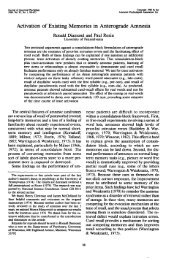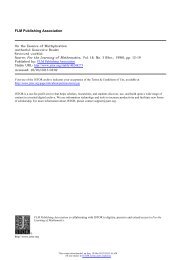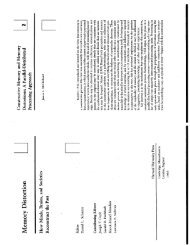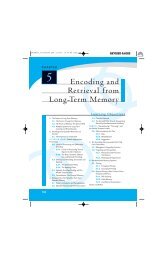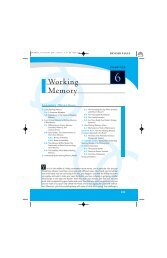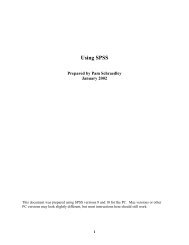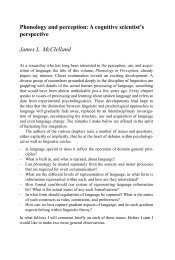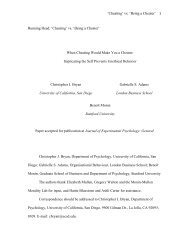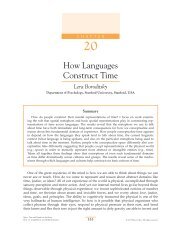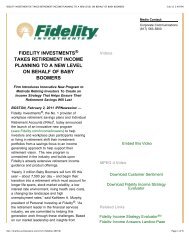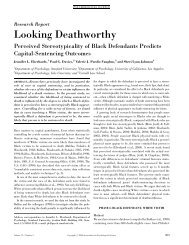Embodied and disembodied cognition: Spatial perspective-taking
Embodied and disembodied cognition: Spatial perspective-taking
Embodied and disembodied cognition: Spatial perspective-taking
Create successful ePaper yourself
Turn your PDF publications into a flip-book with our unique Google optimized e-Paper software.
spontaneously adopting the opposing <strong>perspective</strong> of the<br />
other is impressive, even if it is not a majority. Seeing a<br />
person eying or reaching for an object may generate an<br />
expectation that the person will act on the objects. The desire<br />
to underst<strong>and</strong> or anticipate the person’s actions may<br />
encourage <strong>taking</strong> the <strong>perspective</strong> of the person likely to<br />
act. This account could lead to the prediction that the<br />
reaching scene should elicit more <strong>perspective</strong>-<strong>taking</strong> than<br />
the looking scene, which was not the case. However, the<br />
suggestion of action may have been strong enough in the<br />
looking photograph. Calling further attention to action by<br />
asking a question implying action may serve as a stronger<br />
suggestion of action, <strong>and</strong> elicit more <strong>perspective</strong>-<strong>taking</strong>.<br />
This possibility is examined in the second study.<br />
Supposing that instead of a person in the scene there<br />
had been an inanimate object such as a coffee pot or a doll;<br />
would participants spontaneously take the ‘‘point of view”<br />
of the inanimate object? This seems improbable. When<br />
asked to take the <strong>perspective</strong> of inanimate objects, people<br />
easily do so (e.g., Bryant, Tversky, & Franklin, 1992) but it is<br />
as if they are imagining themselves in that position. If, as<br />
tested in the next experiment, emphasizing action increases<br />
<strong>perspective</strong>-<strong>taking</strong>, then the likelihood of spontaneously<br />
adopting the <strong>perspective</strong> of an inanimate object<br />
would seem even lower.<br />
3. Study 2: highlighting action increases <strong>perspective</strong><strong>taking</strong><br />
The presence of a person in a scene prompts some viewers<br />
to adopt the person’s <strong>perspective</strong> in describing spatial<br />
relations in the scene. Both underst<strong>and</strong>ing action <strong>and</strong><br />
responding to it might be facilitated by <strong>taking</strong> the <strong>perspective</strong><br />
of an actor. Would asking a question that calls attention<br />
to action increase this effect? Here, participants<br />
viewed the photograph of the person reaching for one of<br />
two objects <strong>and</strong>, as before, were asked about the location<br />
of one object relative to the other. The influence of action<br />
on spatial <strong>perspective</strong> was tested by questions that called<br />
attention either to action or to static information. If<br />
emphasizing action affects encoding of spatial <strong>perspective</strong>,<br />
then a question drawing attention to action should promote<br />
<strong>perspective</strong>-<strong>taking</strong> more than a question drawing<br />
attention to static information. The task dem<strong>and</strong> conjecture<br />
was tested by questions that did or did not call attention<br />
to the other person.<br />
3.1. Method<br />
Thirty-three Stanford University <strong>and</strong> 121 University of<br />
Oregon undergraduates were presented with the photograph<br />
in Fig. 1 showing a person at a table reaching for<br />
one of the two objects on the table. Participants were asked<br />
one of four questions about the spatial relations between<br />
the objects. Two of the questions mentioned action: ‘‘In<br />
relation to the bottle, where does he place the book?”<br />
(n = 39) <strong>and</strong> ‘‘In relation to the bottle, where is the book<br />
placed?” (n = 37). The other two questions implied no action:<br />
‘‘In relation to the bottle, where is his book?”<br />
(n = 38) ‘‘In relation to the bottle, where is the book?”<br />
Author's personal copy<br />
B. Tversky, B.M. Hard / Cognition 110 (2009) 124–129 127<br />
(n = 40). Note that one version of each question type mentioned<br />
the person in the scene <strong>and</strong> the other did not. The<br />
photograph <strong>and</strong> question were embedded with unrelated<br />
questionnaires <strong>and</strong> completed for course credit.<br />
3.2. Results <strong>and</strong> discussion<br />
As before, the responses were scored as self <strong>perspective</strong><br />
if the answer was from the viewer’s viewpoint, other if the<br />
answer was from the person viewpoint, <strong>and</strong> neutral if the<br />
answer was from neither <strong>perspective</strong>, for example, ‘‘next<br />
to.” Five participants (4 self <strong>and</strong> 1 other <strong>perspective</strong>) specified<br />
both <strong>perspective</strong>s. Again, the first <strong>perspective</strong> given<br />
determined the coding category. Binary variables were<br />
again created based on the scored responses. Each of these<br />
variables was analyzed using a factorial Analysis of Variance<br />
with question types as factors: mentioning action<br />
crossed with mentioning the person in the scene.<br />
When the spatial questions referred to action, the frequency<br />
of <strong>taking</strong> the other’s <strong>perspective</strong> increased. Fig. 3<br />
shows that more participants took the other person’s <strong>perspective</strong><br />
when the question referred to action (M = .50,<br />
SEM = .06) than when it referred to static information<br />
(M = .33, SEM = .05), F(1,150) = 4.35, p < .05, g 2 = .03. Notably,<br />
when the question mentioned action, approximately<br />
50% of the participants took the other’s <strong>perspective</strong> <strong>and</strong><br />
only 20% took their own <strong>perspective</strong>. In contrast, more,<br />
but by no means all, participants took a self <strong>perspective</strong><br />
when the question referred to static (M = .44, SEM = .06)<br />
than to action information (M = .22, SEM = .05),<br />
F(1,150) = 8.37, p < .01, g 2 = .05. The proportion of participants<br />
<strong>taking</strong> each <strong>perspective</strong> for the static questions replicated<br />
the findings of Study 1. Altogether, calling attention<br />
to action increased the frequency of adopting the other’s<br />
<strong>perspective</strong> but calling attention to the person did not.<br />
In contrast to referring to action, referring to the person<br />
in the scene had no effects on the tendency to take the<br />
other’s (F(1,150) < 1) or one’s own <strong>perspective</strong><br />
(F(1,150) = 1.48, p = .23). There was a significant interaction<br />
on the frequency of adopting a self <strong>perspective</strong>,<br />
F(1,150) = 8.65, p < .01, g 2 = .05. When the actor was mentioned<br />
in the question, referring to action yielded fewer<br />
self <strong>perspective</strong> responses (M = .08, SEM = .04) than static<br />
phrasing (M = .50, SEM = .08). However, when the actor<br />
was not mentioned, referring to action yielded equivalent<br />
numbers of self <strong>perspective</strong> responses (M = .38, SEM = .08)<br />
as static phrasing (M = .38, SEM = .08). This interaction<br />
did not hold true for the proportion of other <strong>perspective</strong> responses,<br />
F(1,150) < 1. Overall, referring to the person in the<br />
scene did not increase the proportion of other <strong>perspective</strong><br />
responses.<br />
As before, the spatial descriptions were sometimes<br />
more complex than simple ‘‘to the right.” Twenty-one percent<br />
of the respondents were explicit as to whose <strong>perspective</strong><br />
they adopted, higher than in the first study. In contrast<br />
to the first study, the proportion of respondents who specified<br />
their <strong>perspective</strong> did not depend on the <strong>perspective</strong><br />
chosen; the proportion of explicit <strong>perspective</strong> was essentially<br />
the same for self (27%) <strong>and</strong> other (30%), Chi-square<br />
(df = 1) = .07, p = .79. Proportion of those making their <strong>perspective</strong><br />
explicit also did not differ depending on whether



